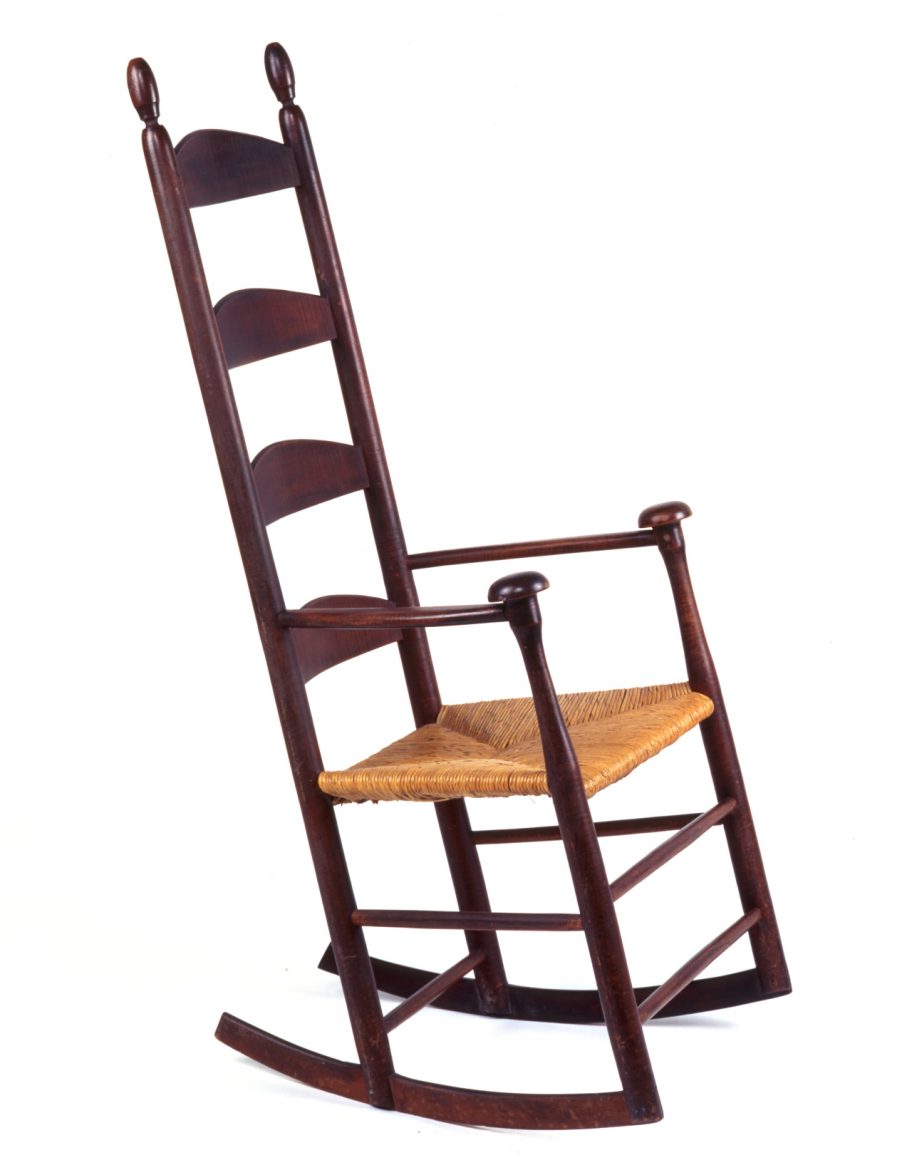
Shaker Museum | Mount Lebanon has partnered with Tappan Chairs in New Hampshire, to offer a limited edition handmade reproduction of one of the rocking chairs in its collection. This rocking chair, a fine example of the work of early chair makers at Enfield, Connecticut, is typical of Enfield rocking chairs – made of figured maple […]

Rocking Chair, Enfield, Connecticut, ca. 1820s, Shaker Museum | Mount Lebanon, 1993.1.24.
Shaker Museum | Mount Lebanon has partnered with Tappan Chairs in New Hampshire, to offer a limited edition handmade reproduction of one of the rocking chairs in its collection.
This rocking chair, a fine example of the work of early chair makers at Enfield, Connecticut, is typical of Enfield rocking chairs – made of figured maple with stretchers of a courser grained wood (probably hickory), with front posts and three-inch diameter mushroom-shaped handholds turned from a single piece of wood, four back slats, minimally shaped rockers that do not protrude beyond the front posts, and finials at the top of the back posts that are typical of Enfield chairs.
The shape of the finials used on Enfield chairs is very similar to those found on chairs made at Watervliet, New York. On the former they are somewhat flatter at the tip, and the neck, just above the cylindrical post, is thinner and more delicate. This thin-necked finial may have been a problem as chairs were tipped over and finials broken, or perhaps the chair makers anticipated this might happen. Either way, a number of Enfield chairs have quarter-inch iron rods inserted from the top of the finial about five inches into the post to strengthen the neck. When we first examined the example at hand we found that where we might expect to find the top end of an iron rod there was only wood. We tested it with a magnet and found no attraction. The initial conclusion was that the Shakers had inserted a wooden dowel through the finial to strengthen it. It seemed unlikely, however, that a wooden dowel, even one of a wood slightly stronger than hard maple, would have improved the strength of the neck enough to make it worth the trouble. Finally, with a stronger magnet held at the neck of the finial, it was clear, as the magnet clung to the neck, that there was indeed an iron rod inside the finial – however, in this case the top of the iron rod had been covered with a small wooden plug rather than being exposed as on other Enfield chairs. In The Shaker Chair by Charles R. Muller and Timothy D. Rieman (The Canal Press, 1984), page 81, the authors illustrate the Enfield finial strengthening with an X-ray, which we reproduce here.

Rocking Chair (detail of finial), Enfield, Connecticut, ca. 1820s, Shaker Museum | Mount Lebanon, 1993.1.24.

X-ray of an Enfield Chair Finial, Enfield, Connecticut, from The Shaker Chair by Charles R. Muller and Timothy D. Rieman (The Canal Press, 1984), page 81. Photograph courtesy of the authors, X-ray technician, Molly Backup.

Reproduction Enfield, CT Shaker Rocker – Limited Edition – From Tappan Chairs
Tappan Chairs, located in New Hampshire, has been in nearly continuous existence since the 19th century and uses traditional methods and equipment. Adam Nudd-Homeyer, proprietor and chairmaker, made multiple study trips to collections storage at Shaker Museum | Mount Lebanon in order to create an accurate but modern version of the Enfield rocker. The finished product features pinned joinery, scribed mortises, mushroom-topped front posts, and filed slats. Made from authentically stained and sealed maple and ash, and seated with a natural rush bottom, the only variations from the original are a slightly larger seat area and longer rockers to prevent tipping.
Only 20 reproduction rockers are available and each is numbered and stamped. The first in the edition was auctioned at the museum’s annual gala in August, 2016. A portion of the proceeds from all sales benefit Shaker Museum | Mount Lebanon. To order for local pick-up in the Old Chatham, New York area, please contact the museum at 518-794-9100. To choose a different finish or a woven tape seat, and for all orders that must be shipped, visit the Tappan Chairs website.